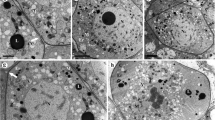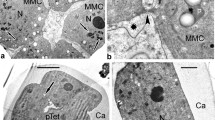Abstract
Our recent study of tetrad pollen formation in Annona (Annonaceae) revealed that after meiosis the callose-cellulose envelope forms a special conjugation with individual microspores and the forthcoming callose digestion is incomplete. The undigested part forms a central binder holding the four microspores of the tetrad together. This process causes the microspores to rotate 180 degrees. In this paper we describe pollen formation in another annonaceous genus, Cymbopetalum, in which the pollen is shed in octads, through use of light microscopy, epifluorescence microscopy, and TEM. In Cymbopetalum, two meiocytes, connected by abundant cytomictic channels, are produced in each sporangium. Octad pollen formation in Cymbopetalum is shown to be comparable to the synchronized formation of two connected Annona tetrads, which then integrate into a single octad. Unique features of Annona polyad formation, e.g. special binding between the callose-cellulose envelopes and microspores, incomplete callose digestion, and microspore rotation, also occur in Cymbopetalum. In addition, formation of the Cymbopetalum octad involves development of a cushion-like structure that binds the distal pronexine of all eight microspores, and there is the production of intine protrusions. The evolutionary origin of the callose-cellulose binding mechanism within the family is discussed.
Similar content being viewed by others
References
A. O. Dahl J. R. Rowley (1991) ArticleTitleMicrospore development in Calluna (Ericaceae) Exine formation. Ann. Sci. Nat. Bot., Paris, 13e serie 11 155–176
G. L. Davis (1966) Systematic embryology of the angiosperms John Wiley & Sons New York London Sydney
J. A. Doyle P. Bygrave A. Le Thomas (2000) Implications of molecular data for pollen evolution in Annonaceae M. M. Harley C. M. Morton S. Blackmore (Eds) Pollen and spores: morphology and biology Royal Botanic Gardens Kew 259–284
J. A. Doyle A. Le Thomas (1994) ArticleTitleCladistic analysis and pollen evolution in Annonaceae Acta Bot. Gallica 141 149–170
J. A. Doyle A. Le Thomas (1996) ArticleTitlePhylogenetic analysis and character evolution in Annonaceae Bulletin du Museum national d'Histoire naturelle, section B, Adansonia 18 279–334
C. Furness P. J. Rudall (2001) ArticleTitleThe tapetum in basal angiosperms: early diversity Int. J. Pl. Sci. 162 375–392 Occurrence Handle10.1086/319580
C. Furness P. J. Rudall F. B. Sampson (2002) ArticleTitleEvolution of microsporogenesis in angiosperms Int. J. Pl. Sci. 163 235–260 Occurrence Handle10.1086/338322
N. I. Gabarayeva (1992) ArticleTitleSporoderm development in Asimina triloba (Annonaceae). I. The developmental events before callose dissolution Grana 31 213–222 Occurrence Handle10.1080/00173139209432033
N. I. Gabarayeva (1993) ArticleTitleSporoderm development in Asimina triloba (Annonaceae). II. The developmental events after callose dissolution Grana 32 210–220
N. I. Gabarayeva (1995) ArticleTitlePollen wall and tapetum development in Anaxagorea brevipes (Annonaceae): sporoderm substructure, cytoskelon, sporopollenin precursor particles, and the endexine problem Rev. Palaeobot. Palynol. 85 123–152 Occurrence Handle10.1016/0034-6667(94)00125-4
D. M. Johnson N. A. Murray (1995) ArticleTitleSynopsis of the tribe Bocageeae (Annonaceae), with revisions of Cardiopetalum, Froesiodendron, Trigynaea, Bocagea, and Horschunchia Brittonia 47 248–319 Occurrence Handle10.2307/2807118
J. Kenrick R. B. Knox (1979) ArticleTitlePollen development and cytochemistry in some Australian species of Acacia Austral. J. Bot. 27 413–427 Occurrence Handle10.1071/BT9790413
R. B. Knox E. Friederich (1974) ArticleTitleTetrad pollen grain development and sterility in Leschenaultia formosa (Goodeniaceae) New Phytol. 73 251–258 Occurrence Handle10.1111/j.1469-8137.1974.tb04622.x
R. B. Knox C. A. McConchie (1986) Structure and function of compound pollen S. Blackmore I. K. Ferguson (Eds) Pollen and spores, form and function Academic Press London 264–282
A. Le Thomas (1980) ArticleTitleUltrastructural characters of the pollen grains of African Annonaceae and their significance for the phylogeny of primitive angiosperms (first part) Pollen Spores 22 267–342
A. Le Thomas (1981) ArticleTitleUltrastructural characters of the pollen grains of African Annonaceae and their significance for the phylogeny of primitive angiosperms (second part) Pollen Spores 23 5–36
A. Le Thomas W. Morawetz M. Waha (1986) Pollen of palaeo- and neotropical Annonaceae: definition of the aperture by morphological and functional characters S. Blackmore I. K. Ferguson (Eds) Pollen and spores, form and function Academic Press London 375–388
J. B. Mols B. Gravendeel L. W. Chatrou M. D. Pirie P. C. Bygrave M. W. Chase P. J. A. Keßler (2004) ArticleTitleIdentifying clades in Asian Annonaceae: monophyletic genera in the polyphyletic Miliuseae Amer. J. Bot. 91 590–600
W. Morawetz M. Hesse (1984) Primäre und sekundäre Aperturen bei Angiospermenpollen C. Clement E. Pacini J.-C. Audran (Eds) Anthere and pollen, from biology to biotechnology Springer Berlin 119–218
N. A. Murray (1993) ArticleTitleRevision of Cymbopetalum and Porcelia (Annonaceae) Syst. Bot. Mongr. 40 1–121
F. Roland (1979) ArticleTitleThe detailed structure and ultrastructure of an acalymmate tetrad Grana 11 41–44
F. B. Sampson (1977) ArticleTitlePollen tetrads of Hedycarya arborea J. R. et G. Forst (Monimiaceae) Grana 16 61–73
F. B. Sampson (1981) ArticleTitleSynchronous versus asynchronous mitosis within permanent pollen tetrads of the Winteraceae Grana 20 19–23
J. J. Skvarla D. A. Larson (1963) ArticleTitleNature of cohesion within pollen tetrads of Typha latifolia Science 140 173–175 Occurrence Handle10.1126/science.140.3563.173 Occurrence Handle17819833
J. J. Skvarla P. H. Raven J. Praglowski (1975) ArticleTitleThe evolution of pollen tetrads in Onagraceae Amer. J. Bot. 62 6–35 Occurrence Handle10.2307/2442074
H. Takahashi (1988) ArticleTitleOntogenetic development of pollen tetrads of Drosera capensis L Bot. Gaz. 149 275–282 Occurrence Handle10.1086/337715
H. Takahashi K. Sohma (1980) ArticleTitlePollen development in Pyrola japonica Klenze Sci. Rep. Tohoku Univ., Ser. IV (Biology) 38 57–71
H. Takahashi K. Sohma (1982) ArticleTitlePollen morphology of the Droseraceae and its related taxa Sci. Rep. Tohoku Univ., Ser. IV (Biology) 38 81–156
H. Takahashi K. Sohma (1984) ArticleTitleDevelopment of pollen tetrad in Typha latifolia L Pollen Spores 26 5–18
C.-H. Tsou Y. L. Fu (2002) ArticleTitleCompound pollen formation in Annona (Annonaceae): proexine formation and binding mechanism Amer. J. Bot. 89 734–747
C.-H. Tsou D. M. Johnson (2003) ArticleTitleComparative development of aseptate and septate anthers of Annonaceae Amer. J. Bot. 90 832–848
E. C. H. Heusden ParticleVan (1992) ArticleTitleFlowers of Annonaceae: morphology, classification, and evolution Blumea Suppl. 7 1–218
M. Waha (1987) ArticleTitleSporoderm development of pollen tetrads in Asimina triloba (Annonaceae) Pollen Spores 29 31–44
M. Waha W. Morawetz (1988) ArticleTitlePollen evolution and systematics in Annonaceae with special reference to the disulcate Australian endemic genera Pl. Syst. Evol. 161 1–12 Occurrence Handle10.1007/BF00936007
Walker J. W. (1971a) Pollen morphology, phytogeography, and phylogeny of the Annonaceae. Contr. Gray Herb. 202: 1–131.
Walker J. W. (1971b) Unique type of angiosperm pollen from the family Annonaceae. Science 172: 565–567.
J. W. Walker (1974) ArticleTitleAperture evolution in the pollen of primitive angiosperms Amer. J. Bot. 61 1112–1136 Occurrence Handle10.2307/2441929
Author information
Authors and Affiliations
Corresponding author
Rights and permissions
About this article
Cite this article
Tsou, C.H., Fu, Y.L. Octad pollen formation in Cymbopetalum (Annonaceae): the binding mechanism. Plant Syst. Evol. 263, 13–23 (2007). https://doi.org/10.1007/s00606-006-0471-4
Received:
Accepted:
Published:
Issue Date:
DOI: https://doi.org/10.1007/s00606-006-0471-4




